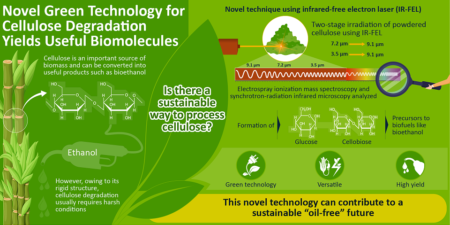Jul
22
Laser Technique Can Convert Cellulose Into Biofuel
July 22, 2020 | 1 Comment
The plant product cellulose is the most abundant form of biomass globally and can be converted into useful products such as biofuels. However, the processing of this biopolymer is cumbersome, owing to its rigid, water-insoluble structure. To overcome this, scientists recently developed a novel laser-based technique that makes cellulose degradation easier. Because this reaction does not require harsh conditions, it can lead to efficient application of cellulose across various industries, especially environmental technology.
With the ever increasing demand for more energy and fuel, it has become important to develop efficient alternatives to fossil fuels. One option is to use clean sources of fuels called biofuels, which can be produced from natural sources such as biomass. The plant-based polymer cellulose is the most abundant form of biomass globally and can be converted into raw materials such as glucose and xylose for the production of bioethanol (a type of biofuel). But, this process is challenging due to the molecule’s rigid and dense structure, which makes it insoluble in water.

Showing a novel laser-based strategy for the effective degradation of cellulose into useful products. Image Credit: Kawasaki, et al, Tokyo University of Science. Click image for the largest view.
Chemists and biotechnologists globally have used conventional techniques like microwave radiation, hydrolysis, and ultrasonication to degrade this polymer, but these processes require extreme conditions and are thus unsustainable.
In a new study published in Energy & Fuels, a research team in Japan, including Dr Takayasu Kawasaki (Tokyo University of Science), Dr Heishun Zen (Institute of Advanced Energy, Kyoto University), Prof Yasushi Hayakawa (Laboratory of Electron Beam Research and Application, Institute of Quantum Science, Nihon University), Prof Toshiaki Ohta (SR Center, Ritsumeikan University), and Prof Koichi Tsukiyama (Tokyo University of Science), developed a novel technique for cellulose degradation.
This technique was based on a type of laser called the infrared-free electron laser (IR-FEL), whose wavelength is tunable in the range of 3 to 20 µm. This new method is a promising green technology for the zero-emission degradation of cellulose.
Dr. Kawasaki said, “One of the unique features of the IR-FEL is that it can induce a multiphoton absorption for a molecule and can modify the structure of a substance. So far, this technology has been used in the basic fields of physics, chemistry, and medicine, but we wanted to use to spur advances in environmental technology.”
This looks quite interesting. Without a measure or assessment of the power used to drive the laser vs the fuel precursor released, its not practical to assume this is a groundbreaking revolution. Perhaps this idea is going to a larger process design from a lab test station kind of thing. We’ll see, if this starts to scale successfully its going to get lots more attention. For now the graphic above will have to suffice for understanding what is going on.
Comments
1 Comment so far


The idea could be technically feasible but unsuitable for commercial use. Laser use may cost more than the biofuel produced. Only cheap natural or nuclear energy could be feasible for fuel production.